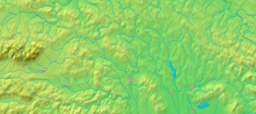Snina
| Snina | ||
| Town | ||
|
View of Snina with Vihorlat Mountains in the background
|
||
|
|
||
| Official name: Bratisjana | ||
| Country | Slovakia | |
|---|---|---|
| Region | Prešov Region | |
| District | Snina District | |
| River | Cirocha | |
| Elevation | 216 m (709 ft) | |
| Coordinates | 48°59′17″N 22°09′24″E / 48.98806°N 22.15667°ECoordinates: 48°59′17″N 22°09′24″E / 48.98806°N 22.15667°E | |
| Area | 59.41 km2 (23 sq mi) | |
| Population | 21,326 (31 December 2005) | |
| Density | 359/km2 (930/sq mi) | |
| First mentioned | 1317 | |
| Mayor | Štefan Milovčík | |
| Timezone | CET (UTC+1) | |
| - summer (DST) | CEST (UTC+2) | |
| Postal code | 069 01 | |
| Phone prefix | 421-57 | |
| Car plate | SV | |
| Statistics: MOŠ/MIS | ||
| Website: http://www.snina.sk | ||
Snina is a town in Slovakia located at the confluence of the Cirocha river and the small river Pčolinka in the valley between the Beskydy foothills and the Vihorlat Mountains. It is the closest town with rail and bus connections to the Poloniny National Park.
The oldest written records mentioning Snina date back to 1317. Snina as an oppidum (small town) is mentioned in port records ("porta" means the gate into a courtyard) beginning in 1585. In 1598 the first census of houses was made and there were 75 houses in the town at that time. Between 1570 and 1630, it is evident from port records that Snina was the seat of the regional krajňa, or administrative district for the surrounding villages. In 1646 Snina was called "Szinna Varossa" and later "Civitas Szinna" in the archives. In 1785 Snina had 195 houses and 1,430 inhabitants.
The town's rulers from 1321 to 1684 were from the Drugeth family, who came from Salerno near Naples. Later, the owner of the lordship of Snina was Terézia van Dernáthová, who was the granddaughter of Žigmung Drugeth. After her death in 1799, her five sons sold all the property to a businessman from Gemer named Jozef Rholl. His children developed the region until 1857. They built an iron and steel works in the Jozef valley in 1809.
Starting in 1839 a traditional market took place in Snina four times a year, which aided the development of business and trade. An iron foundry was built in the Jozef valley in 1841. A well-known moulded statue of Hercules was placed next to the Snina manor-house and is the emblem of Snina to this day. During a decline in business in 1873, the iron and steel works completely vanished, so life for the citizens of Snina and its vicinity worsened rapidly and large-scale migration began. They left their homes and went to the United States, Canada and western Europe.
In 1876 Snina was a residence of the 10th region of the Zemplín area. The Roman Catholic classicist church from 1751 was modified at the beginning of the 19th century. A classicist Calvary in the cemetery dates from 1847. There is a manor-house from 1800 in the town set in a planned historical park, which is from the 19th century. In the courtyard of the manor-house is a public fountain with a well-known statue of Hercules from 1841. In the church's park there are monuments from World War II. There are also two military cemeteries from World War I near the town (Giglov has 130 graves of soldiers and Brehy has 153).
...
Wikipedia






